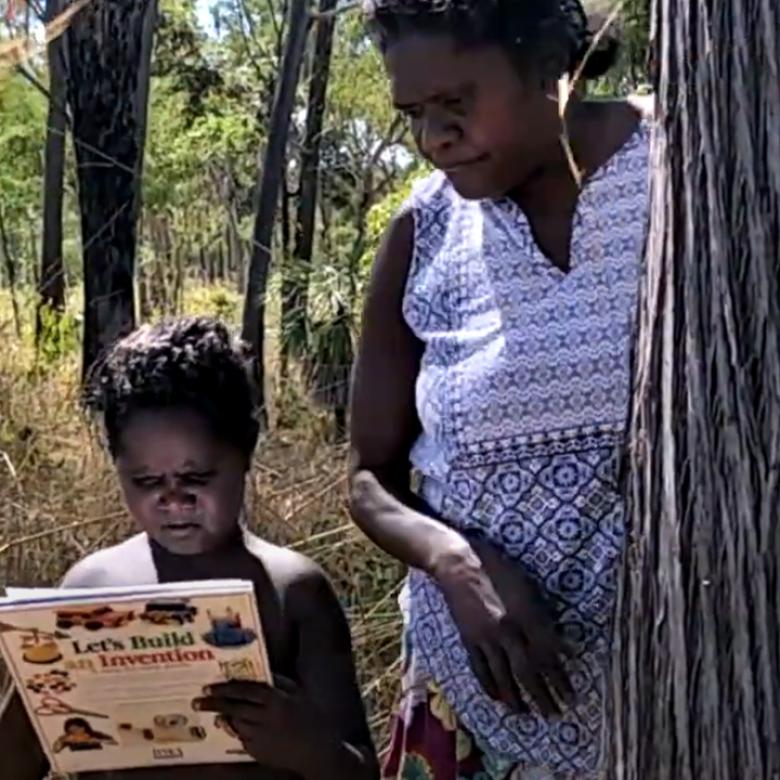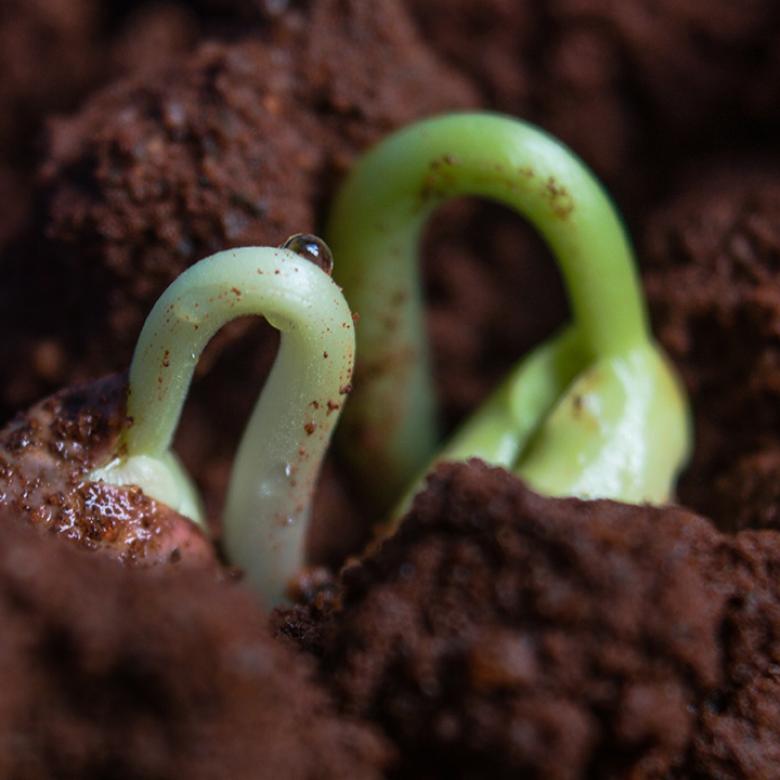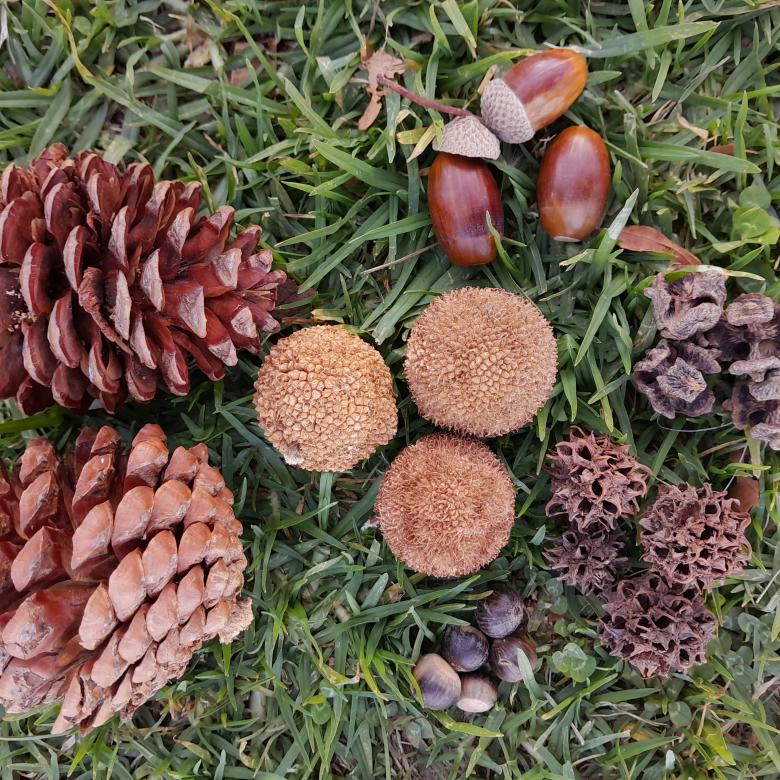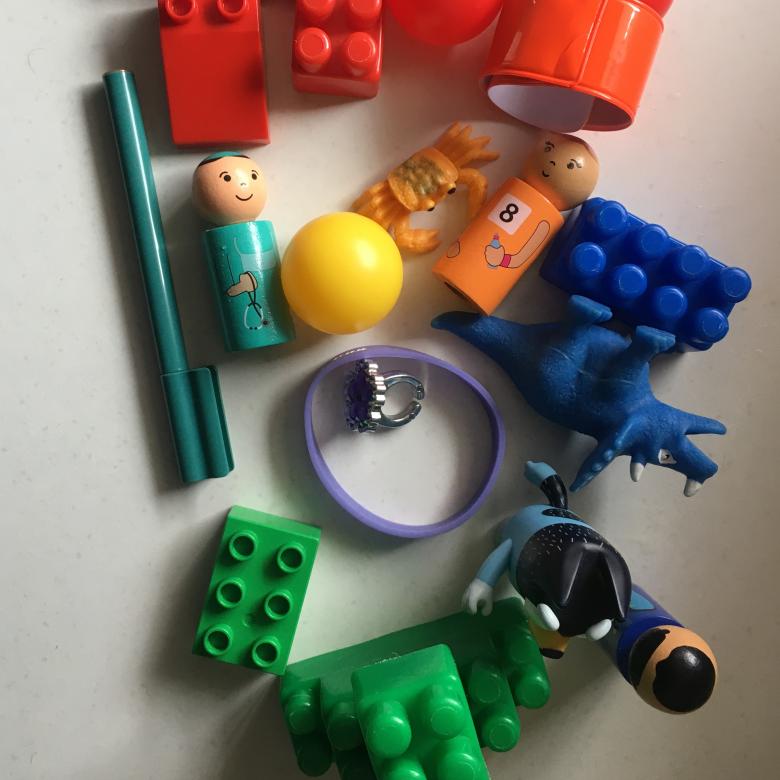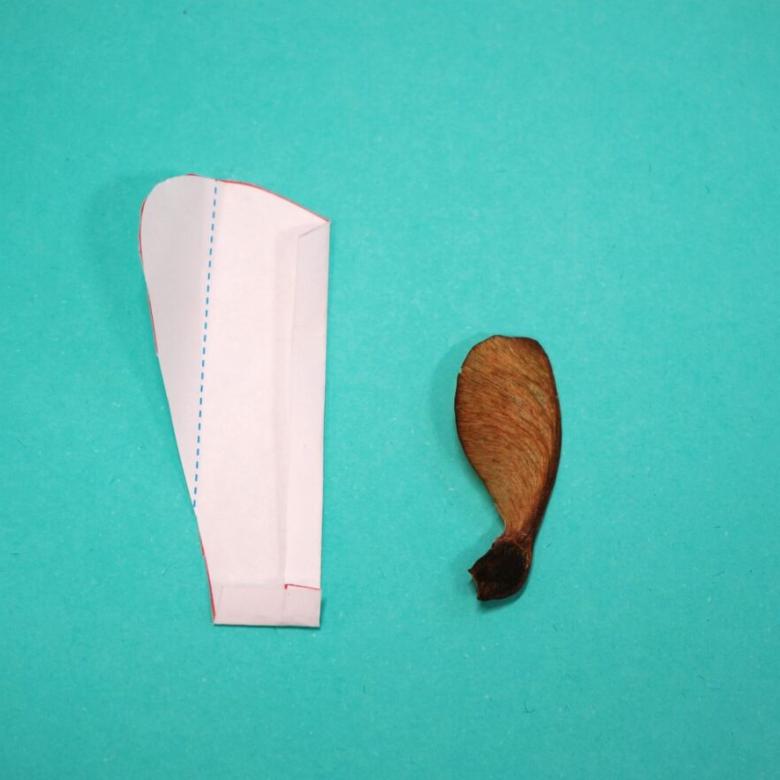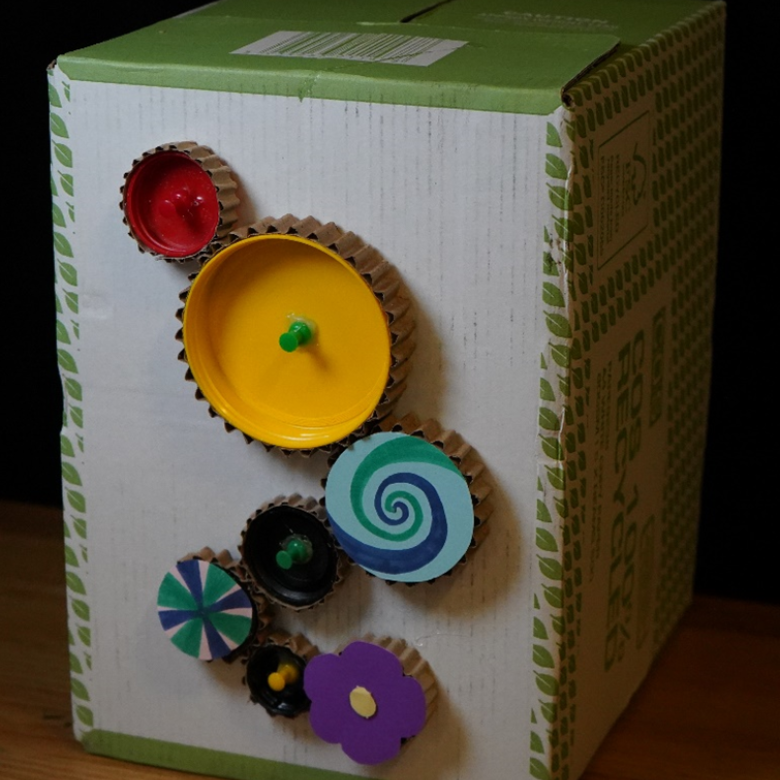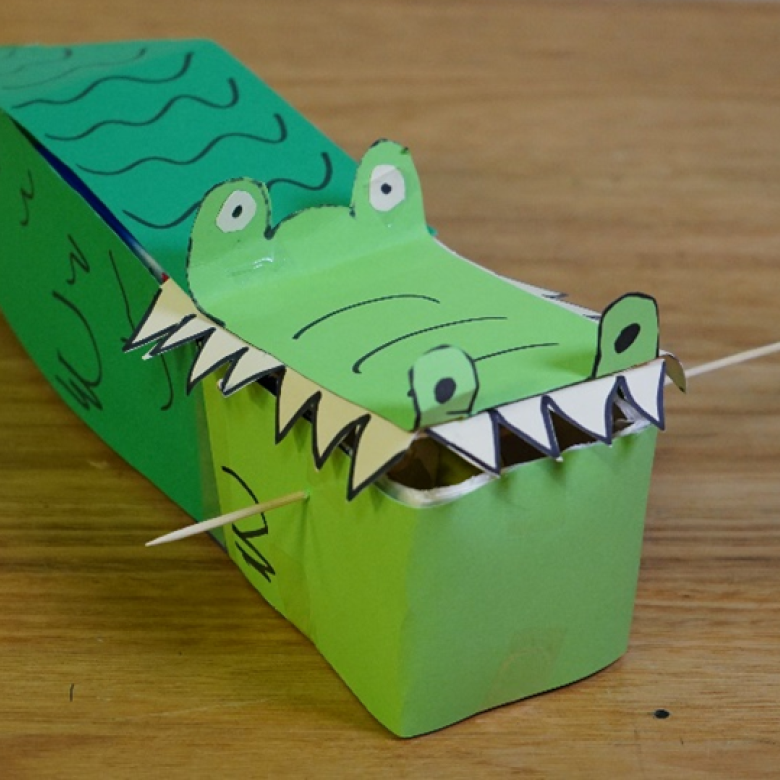You’ll need
- A large mixing bowl
- 2 cups of cooking salt
- 5 cups of plain flour
- 2 cups of warm water
- Food colouring (optional)
- A baking tray (non-stick, or use baking paper)
- A skewer
- An oven and oven mitts
What to do
- Gather your materials on a flat surface.
- Ask an adult to preheat the oven to 150 °C.
- Put the flour and salt in the bowl.
- Add the food colouring (if you are using it) and most of the water. Mix with your hands to make a ball of firm dough.
- If the dough is too dry, add a little bit more of the water and mix again. You might use less than the 2 cups of water. If you add too much water and the dough is mushy, add more flour and mix again to make it firm.
- Put the ball of dough on the baking tray and press your hand into the dough. To make a footprint instead, put the baking tray of dough on the floor and press your foot into the dough.
- Use the skewer to make a small hole all the way through the top of your print. This will be used to hang the print when it is finished. You can also use the skewer to write your name and the date.
- Ask an adult to bake your print in the oven at 150 °C for 1 hour. Let it cool.
- When your print has cooled, you can paint it and tie some string through the hole to hang it.
Questions to ask
Dinosaurs didn’t have ovens to dry out their footprints. What do you think made their footprints last so long?
What's happening
When you mix the dry flour with water, they combine to make a sticky dough because the water holds the flour together. A similar thing happens with dry soil – when you add water, it sticks to the soil to make mud!
Unlike dry flour, the dough holds its shape, which means you can make a print of your hand or foot. Many dinosaur footprint fossils were made when the dinosaur walked through mud, leaving behind imprints of their feet.
Baking the dough in the oven dries it out, while keeping it in the shape that you formed. For real dinosaur footprints, the mud dried out in the sun, helping to keep the shape of the footprint.
Did you know
- Dinosaurs became extinct about 65 million years ago.
- Some dinosaurs ate meat, some ate insects and some ate plants.
- The word dinosaur means ‘fearfully great lizard’, but dinosaurs are quite different from today’s lizards. Dinosaurs are much more like birds. Scientists say birds evolved from dinosaurs while dinosaurs were still alive.
BJ: Hi welcome to Questacon Science Time. My name’s BJ.
Dion: And I’m Dion.
BJ: And today we’re talking about
BJ & Dion: Dinosaurs.
BJ: Come and join us.
(Introduction music)
BJ: Welcome to Science Time everyone. Now, in a big loud voice, can you tell me – what are we talking about in Science Time today?
Children Dinosaurs!
BJ: Dinosaurs! Who can growl like a dinosaur?
Everyone Roar!
BJ: Fantastic! love dinosaurs. Now, can anyone put up their hand and tell me their favourite dinosaur? What’s your favourite dinosaur?
Child: I like Tyrannosaurus Rex.
BJ: You like Tyrannosaurus Rex. Who else likes Tyrannosaurus Rex. Yeah, excellent! What dinosaur do you like?
Child: Tyrannosaurus Rex.
BJ: Tyrannosaurus Rex. What dinosaur do you like? Do you want to keep thinking? You keep thinking. What dinosaur do you like?
Child: Tyrannosaurus Rex.
BJ: Tyrannosaurus Rex.
Dion: It’s a very popular one. Does anyone like another dinosaur that’s not a T-Rex?
Children Yes.
BJ: What dinosaur do you like?
Child: Triceratops.
BJ: Triceratops.
Child: I like a flying dinosaur.
BJ: Oh, a flying dinosaur. We’ll talk about that one soon. ‘
Child: I like a Pteranodon.
BJ: Yes. We’ll talk about that one soon. What one do you like?
Child: Um… A T-Rex.
BJ: A T-Rex, they’re cool. What dinosaur do you like?
Child: A Velociraptor
BJ: A Velociraptor, with it’s little claws. And what dinosaur do you like? Have we talked about your favourite dinosaur yet? Now, I’m going to show you one of my favourite dinosaurs. You need to guess what it is. It has little arms like this and it’s got a big mouth like this. What is it?
Child: T-Rex.
BJ: Tyrannosaurus Rex. Here we go. And they were big, weren’t they? With their big teeth. You know some dinosaurs ate meat and we call them carnivores. Can you say carnivores?
Children Carnivores.
BJ: Carnivores.
Child: Carnivores.
BJ: Carnivores. Some animals ate plants and we call those Herbivores. Can you say that?
Children: Herbivores.
BJ: Herbivores. Now look at the T-Rex –
Child: If it’s green it’s good.
BJ: Oh, if it’s green it’s good.
Dion: That’s what a herbivore would say.
BJ: Green food is healthy and good for you, isn’t it? Yes, herbivores thought that.
Child: Even red stuff is good for you too. Like tomatoes.
BJ: Yes, certainly. Back to the T-Rex. Do you think he was a meat eating carnivore or a plant eating herbivore?
Child: Meat eater.
BJ: A carnivore. Can we say that word?
Everyone: Carnivore.
BJ: T-Rex is a carnivore. Now there’s another dinosaur. Let me see if you can guess. It has big long neck and a big long tail.
Child: Tyrannosaurus Rex
BJ: Good guess. What do you think?
Child: An Apatosaurus.
BJ: An Apatosaurus. Well done.
Dion: Good work.
BJ: Here is our Apatosaurus. Can you stretch your next really long like and Apatosaurus? And show me your big, long tail. Oh, you make wonderful Apatosaurus. Excellent. Now, do you think an Apatosaurus was a carnivore that ate meat or a herbivore that ate plants?
Children: A herbivore.
BJ: A herbivore. It’s a herbivore that ate plants.
Child: And leaves.
BJ: Yes, and leaves and bushes, absolutely. With it’s big, long neck it would stretch up to the top of the trees. Now there’s another dinosaur I’m thinking about that has horns.
Children Triceratops.
BJ: Triceratops. Excellent. Can you show me your horns like a Triceratops? Excellent. Very good.
Child: They use them to head butt.
BJ: They would. They’d use them to head butt each other.
Child: They have one on their nose as well.
BJ: Can you show me your nose horn? Well done. They’ve got three all together. Two on their head and one on their nose. Now, is a Triceratops a carnivore that ate meat or a herbivore that ate plants? What do you think?
Child: Carnivore.
BJ: Do you think a carnivore that ate meat? Does any one else think something?
Child: Herbivore.
BJ: You think a herbivore? Yeah? Now carnivores like the T-Rex have big teeth. Does the triceratops have big teeth? So, what do you think he might have been? A….
Children Herbivore.
BJ: Yeah. He was a herbivore.
Dion: Just like the Apatosaurus, which doesn’t have very big teeth either. Most dinosaurs that had small teeth are herbivores.
Triceratops: Oh, I like to eat plants.
Apatosaurus: So do I.
Triceratops: Let’s go and eat some plants together.
BJ: Now there’s another dinosaur I’m thinking of. This one has plates down its back.
Child: I know. Stegosaurus
BJ: Stegosaurus, yeah.
Child: There’s a Stegosaurus bone over there.
BJ: Behind us we’ve got a big plate of a Stegosaurus. We’ll have a closer look at that later.
Dion: We’ll look at that soon.
BJ: Now here’s his head. I’ll turn him around this way. And he’s got big plates. Can you show me your big plates, down you’re back like a big Stegosaurus. Lovely. And look at his mouth there. Do you think he’s a carnivore or a herbivore?
Children: Herbivore.
BJ: A herbivore. Good guess, good guess. A herbivore, you’re right. He liked to eat plants.
Stegosaurus: I going to come and eat plants some plants with you.
BJ: Now, there’s another dinosaur I’m thinking about. It has claws on its feet. Big claws.
Child: Velociraptor
BJ: Velociraptor, well done! Now here’s our toy of a velociraptor, and you can see the claws on his feet. What do you think he might have used his claw for?
Child: For being a meat eater.
BJ: Yeah! Is he a herbivore or a carnivore? A carnivore, he was a carnivore who ate meat wasn’t he? Do we know what he might of used that claw for?
Child: Scratching!
BJ: Scratching. Good guess, yeah!
Child: Ripping skin!
BJ: Ripping skin! Yeah. I think he used it to poke other dinosaurs. So he could eat them because he was a carnivore. He ate other dinosaurs didn’t he? Now have a close look at our velociraptor, do you see he has feather on his head, and feather on his arm? It is a bit strange isn’t it?
Child: He looks like a bird!
BJ: He looks like a bird. You know Scientists think that a lot of Dinosaurs had feathers, just like birds. Now there were other animals that lived at the same time as dinosaurs. Lets have a look, what were those animals? What is this one?
Children Crocodile!
BJ: A crocodile! Now crocodiles lived at the same time as dinosaurs, but is a crocodile a dinosaur?
Children No.
BJ: No it’s not.
Child: It’s a reptile.
BJ: It’s a reptile, and you can see the difference in their legs. The dinosaur has legs that go straight down and the reptile has legs that go out to the side. So can you show me your dinosaur legs? Straight down. Big straight dinosaur legs. Can you show me your bendy reptile legs? Ha! Well done! There’s another animal that lived at the same time as the dinosaurs!
Children: A pterodactyl.
BJ: A pterodactyl!
Child: That’s what I was going to say was the kind of Dinosaur I like.
BJ: That’s the kind of dinosaur you like! A pterodactyl.
Child: No the pterodactyl is not a real dinosaur!
BJ: Well done! It’s a reptile, just like a lizard. Well done, it is. Well done. Come and sit down. You are right, it is not a dinosaur. It’s a reptile, just like a lizard. Now dinosaurs and pterodactyls are not alive anymore, they’re what we call extinct. Can you say that word with me?
ALL: Extinct.
Child: Cats are extinct!
BJ: Oh are they? That means the whole lot of them are not alive anymore, no they’re extinct. But, do you know there is an animal that is alive today that scientists think have evolved from dinosaurs. Now this animal has feathers, just like a lot of dinosaurs did. Now what animal has feathers?
Child: A bird.
BJ: Birds! Birds may have evolved from dinosaurs. Yeah. Now how do we know about dinosaurs? People, scientists called palaeontologists have fossils of these big dinosaur bones and they put them all together like a jigsaw puzzle. So then we know that there were these big animals that aren’t alive anymore.
Child: They’re like a skeleton.
BJ: Yeah just like a skeleton, and then they take them to the museum so everyone can see them/ So we’ve got lots and lots of things to play with at Science Time today. You ready to go have a play? Ready set go! Go have a play!
[Children (with their caregivers) are exploring, observing and playing with all the toys and experiments focused on “Dinosaurs” in the Science Time room.]
Dion: So while everyone else is playing, we’re going to go visit someone else special at Questacon. Come with me!
Dion: Hi boys and girls! Here we are today with Mutty the Muttaburrasaur. Questacon’s own dinosaur. Can everyone say ‘Hi Mutty!’
Mutty: Hi everybody!
Dion: So Mutty tell us where do you come from?
Mutty: Well muttaburrasaurs came from outback Queensland near a town called Muttaburra. Now I’m not completely sure but I think Muttaburra was named after muttaburrasaurs.
Dion: Probably not. Probably the other way around Mutty.
Mutty: I find that very upsetting.
Dion: I thought you might actually. Now Muttaburrasaurs, what sort of things do they eat?
M:utty Muttaburrasaurs love to eat lots and lots of cool crazy things like… plants and vegetables and trees… and plants.
Dion: Now does that make you a herbivore Mutty?
Mutty: No I’m a HISbavore because I’m a boy!
Dion: No Mutty is actually a herbivore which means he eats nothing but plants and vegetables…
Mutty: And chocolate and chips and lollies!
Dion: Only on very short occasions. What other sort of dinosaurs were there in Australia?
Mutty: There were lots of different dinosaurs, some were really really big. I’m really quite small.
Dion: In comparison to all the rest? Ahh ok so what’s….
Allosaur: RRRRRRRRAAAAARRRRRRGGGGGHHHHHHH!!!!!!!!!!!!!
Dion: I think that’s the sound from a very big Australian dinosaur.
BJ: Hi boys and girls, this is a big dinosaur that used to live in Australia. It’s an Allosaur!
Dion: This is Allie the Allosaur! Everyone say ‘Hi Allie the Allosaur’!
BJ: Hi Allie! RARGH!
Dion: So what sort of things did Ali eat?
Mutty: Me! AAAARRRGGGHHHH!!!!!
BJ: I think he liked to eat other dinosaurs. He was a carnivore! Rargh!
Dion: So Allie liked to eat meat, so that makes him a carnivore, and Mutty only ate plants which makes him a herbivore. So you both came from Australia did you?
BJ: Yep yep! They sure did.
Mutty: There was amazing fun times with dinosaurs in Australia. There was dinosaurs everywhere and some were fast and some were slow and some were just huge.
Dion: So there were lots of different dinosaurs to see in Australia, and here at Questacon as well. So if you want to see a dinosaur, come along to one of our dinosaur puppet shows that we have here at Questacon. You’ll be able to meet Mutty, and maybe even Allie the Allosaur as well. So everyone say ‘Bye Dinosaurs!’
Mutty: Bye!
Dion: And we’ll go back and see what everyone else is doing in Science Time.
BJ: Rargh!
Mutty: Waaaaa!
BJ: What do you think this might be?
Child: A stegosaurus plate.
BJ: A stegosaurus plate! Can you show me your plates like a stegosaurus? They’re really huge, this is how big a stegosaurus plate would have been.
Child: All of them?
BJ: Most of them would have been this big. Baby ones would have had smaller ones and there might have even been some bigger than this. I wonder! Thanks you Dion. Now what do we think this might be?
Child: A triceratops horn!
BJ: A triceratops horn! Can you show me your horns like a triceratops?
Child: How did it come off?
BJ: Now that’s a very good question, how did it come off? This one would have been found with a whole skeleton a fossilized skeleton and it came off because the dinosaur is not alive anymore. But when it was alive it would have been on nice and tight. Now this is the bone of the horn, but there would have been enamel that covered the horn. So it would have been even bigger and sharper than this.
Child: But this isn’t very sharp.
BJ: No this isn’t very sharp because it’s just the fossilized bone. Now there’s something else I wanna show you… What do you think this might be?
Child: A tyrannosaurus rex tooth.
BJ: A tyrannosaurus rex tooth! Look how big this tooth is. Show me your teeth! Are your teeth this big?
Child: No.
BJ: No. It was really big and sharp, and this is how big the root was to make the tooth really strong for crunching up other dinosaurs. Because a T-Rex were they carnivores or herbivores. They were carnivores, they ate meat.
Child: Can it crunch through our bones?
BJ: It could crunch through bones, because it had big strong teeth. That’s a good question. Now here’s another dinosaur fossil I want to show you. This is a replica. What do you think this might be? Maybe a horn, maybe a tooth, maybe a tail. What do you think it might be?
Child: A claw?
BJ: A claw! This was a foot claw! From a raptor, a utahraptor this one. Just like a toenail, a big toenail. And what do you think it used this claw to do?
Child: To stick into other animals.
BJ: To stick into other dinosaurs!
Child: To open them up!
BJ: To open them up yeah! Because a utahraptor is a carnivore! It liked eating meat! Now there’s two more things I wanna show you. What do you think this might be? It’s a dinosaur egg! Remember lots of dinosaurs had feathers, just like birds, and they all laid eggs, just like birds. So inside this egg a little dinosaur would have grown this is from an Ovaraptor, and bigger dinosaurs had bigger eggs. A big long neck apataurus would have had a bigger egg. Maybe as big as a football.
BJ & Dion: That’s pretty big!
BJ: Now all of these dinosaur fossils I’m showing you here, they’re replicas. But here, I’ve got a real dinosaur fossil. One hundred and ten million years old, what’s this do you think?
Child: A poo!
BJ: Well done, it’s a dinosaur poo! But over 110 million years, it’s fossilized, so it’s now turned into a rock. So it doesn’t smell anymore. But it used to be dinosaur poo!
Dion: The scientific name for dinosaur poo is Coprolite. Can everyone say Coprolite?
All: Coprolite!
BJ: That’s fantastic. 110 million years old. That’s a long long long time! So we’ve been seeing lots of fantastic dinosaur stuff in Questacon today, and Dion and I have some fun things for you to take home with you. First we have a parent information sheet, with activities and websites, songs… lots of fun stuff to do at home. Boys and girls at home you can download this and look at it at home. You’re going to get one for nana? Fantastic idea! There’s one other thing I’ve got for you to take away today.
Child: Colouring in!
BJ: A colouring in sheet! Here there’s two dinosaurs, a tyrannosaurus rex, eating meat because he’s a carnivore! Here’s along neck dinosaur, a bit like an apatosaurus and she’s eating some leaves, because she’s a herbivore. Now remember, one last thing I wanna tell us all. Do you know, we don’t know what colour dinosaurs used to be? They could have been pink or purple or blue or green or red. We have no idea what colour they were. So you’ll need to use your imagination, and I want you to colour this in any colour you like. What colour might you colour your dinosaur?
Child: Pink.
BJ: Pink, I think that might be lovely. Now before we give them out can we look at the boys and girls at home and can we wave goodbye and say..
All: See you next Science Time!
BJ: Bye! Come and get a picture.


